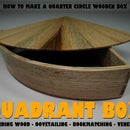Introduction: Kawai Tsugite - Amazing Three-way Japanese Joint
This joint can be assembled three different ways - one in a straight line, two at right angles! It's a pretty weak joint, but boy is it a talking point. I hope to demystify it for those who would like to make one themselves, and believe me, it's a lot of fun to do, and great practice for sawing and paring.
Don't be daunted. Having worked out how to make it myself yesterday, I can give you all the instructions you need, and assure you that it isn't too hard to try. Getting a perfect fit in all three positions without it being sloppy is a challenge, and I could certainly improve on my effort in the future.
So, what will you need?
Materials:
- A length of square stock. Something like lime would be ideal as it is great to carve, but I used dark red meranti.
Tools:
- A back saw. Japanese or western is fine, and a thin kerf is best
- Chisel(s). Straight and skew chisels are a great help
- Marking gauge
- Try-square. A machinest's all metal square is best, but a carpenter's square is okay
- Mitre-square.
- Bevel gauge.
- Marking knife. A sharp pencil would be okay
- And preferably a workbench, vise, and bench hook
Step 1: Preparation
Plane the stock square all round
Both parts must be the same dimensions in width and thickness
I used a single piece, cutting it in half after squaring all round (this will allow a grain match when assembled in a straight line)
Shoot the ends square to the sides
Step 2: Marking Out (1)
Set the marking gauge to half the thickness
Mark a cross on both ends, and extend the ends of it down the four sides
Mark a band around the pieces, with the same gauge setting working from the ends
Reset the gauge to the full thickness
Mark a band around the pieces again
You should now have a cube marked on the end, each face of which is divided into four squares
Use a mitre square to define a full corner of the cube to remove (match the diagonals to ensure a grain match when assembled straight)
Step 3: Removing the Corner
Saw off the corner you just marked on each piece, and clean off the face to the marked lines
Step 4: Star Cuts
Set a bevel gauge to 22.5° and lay in the lines shown in the photo
These are the lines to saw to, and they extend around the back to meet the diagonal lines marked previously
Saw the three cuts that make up the star pattern
Step 5: Remove Waste
At the base of the 'removed' corner, you can saw a shoulder between the two star cuts
After that it's all chisel work
Carefully chisel away the bottom section from the star as shown, before removing the two other sections at the opposite corners (these are easier, as the saw cuts have done more of the work)
You need to continue until you form a base in these cavities that lies in the same plane, and which is parallel to the surface from where the original large corner was removed
Step 6: Assemble - Three Ways!
If you've removed sufficient waste, then the two pieces can now be joined together, in three different ways!
Don't expect perfection on your first attempt - mine certainly wasn't. Practice should make it better, and I'll be trying to fit some in soon.
Thanks for reading my instructable, and watching the video. There are plenty more joints and other stuff both on my Instructables page and Youtube channel.
Cheers,
Mitch




